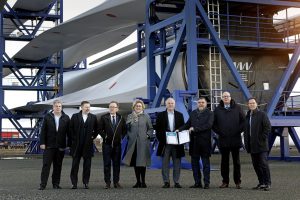Six of Europe’s leading wind ports join forces
 Even though they are usually competitors, representatives of the six largest wind ports in Europe shook hands and signed a declaration Port Esbjerg in Denmark on 18 January.
Even though they are usually competitors, representatives of the six largest wind ports in Europe shook hands and signed a declaration Port Esbjerg in Denmark on 18 January.
They have agreed to join forces to speed up the green transition in order to meet Europe’s ambitious offshore wind deployment targets. The ports lack capacity. The European offshore wind strategy target is to deploy at least 65GW of offshore wind by 2030. A tall ask. Not least considering that there is currently just over 13GW in the seas around Europe. In other words, Europe aims to install well over five times as much offshore wind in the next eight years as we have built during the previous twenty years.
This target puts great pressure on European wind ports because there is currently not enough port capacity to install all these offshore wind farms by the deadline. Six of Europe’s leading wind ports will try to change that. Although they are competitors, they have joined forces in a collaboration, sealed today at Port Esbjerg where a declaration was signed and the first discussions and sharing of experiences took place. The aim is to collaborate at an operational and practical level.
“We, Europe’s leading offshore ports, will be crucial to accomplish this massive expansion of European offshore wind capacity. We are fully committed and stand ready to do our part of the work. By strengthening cooperation between the ports, operationally and practically, we can lay the groundwork that will lead to future extensions and sufficient capacity,” it says in the declaration
According to the six involved CEOs, the ports also want to send a signal to the market that the ports are willing to do anything to accelerate the green transition with offshore wind. The six ports that have entered the unique collaboration are Port Oostende in Belgium, Groningen Seaports/Eemshaven in the Netherlands, Niedersachsen Ports/Cuxhaven in Germany, Nantes-Saint Nazaire Port in France, Humber in the UK and Port Esbjerg in Denmark.
As offshore ports, they will contribute to knowledge sharing and best practice while respecting competition legislation. The ports may, for example, collaborate on getting around the issue of space shortages. If one port only has space for half a project, another port may have space for the other half. The ports will also try to ensure optimal processes and, for example, share digital experiences. Port Esbjerg has just developed a digital tool, a so-called digital twin, to help triple the capacity of offshore wind in the future, without having to expand. The ports’ collaboration should also support the political work in Europe.






